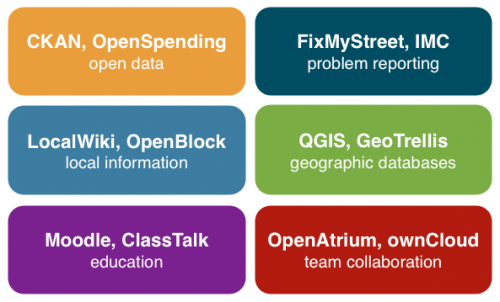App Statistics
As of today there are 32 apps listed on the website. The breakdown of apps by city function can be seen in the following pie chart:
The most commonly used technologies for the apps currently on ICOS are as follows:
The most common licenses used for the apps are the GPLv2 or v3 license (19 apps) and the AGPLv3 license (5 apps). Some of the rest of the apps are licensed under the MIT, Apache and BSD licenses.
App Categories
There are many examples of apps related to e-governance and open data (OpenGovernment, OpenSpending, CKAN, Open Data Catalog, OpenPublic). Another important area of interest for applications is citizen participation, either in decision-making processes or in distributed data gathering / crowd-sourcing (OpenTreeMap, DistrictBuilder, All Our Ideas, Textizen, FixMyStreet, Improve My City, Shareabouts, OpenBlock, LocalWiki).
On the other hand, as of today, there is a lack of available applications in some of the other categories. The city functions related to “Quality of Life” and “Infrastructure and Utilities” are under-represented (e.g. there are no apps listed in relation to safety and security in the city, or pertaining to cities’ network infrastructures, such as energy networks or broadband). Furthermore, some of the sectors under “Innovation Economy” are not represented either (e.g. manufacturing, financial services or agriculture). There is of course more work to be done in finding open-source apps around the web, but the lack of representation in these areas could be also attributed to the following factors:
- Some of these applications are of interest to a limited number of organizations. Applications for safety and security, for example, are mainly of interest to the police, and that could make them more appropriate to be developed as proprietary solutions.
- Applications related to commercial activities are also more likely to be sold as proprietary solutions in the form of complete software packages with included technical support and maintenance. Also, some of the proprietary software already used in businesses can be very hard to change, such as banks’ database systems or factories’ asset management software.
App Maturity
Some of the apps on ICOS are in a mature state of development and consequently have relatively extensive feature sets, as well as complete documentations. Examples of “mature” apps are Quantum GIS, Moodle, OpenAtrium, LimeSurvey, and Drupal. Conversely, some other apps do not have that level of maturity, either because they were developed for a specific purpose or a specific place (e.g. Water Storage or Look at Cook), or because they do not have a particularly active user base and therefore are limited in terms of documentation (e.g. Open Data Catalog or Zanby). While not prohibitive, these limitations mean that those apps might need more effort in terms of customization or installation on the part of the implementing authority.
App Showcase
Twelve apps that seem to sufficiently cover the needs of six specific areas of interest are presented in the following image:



